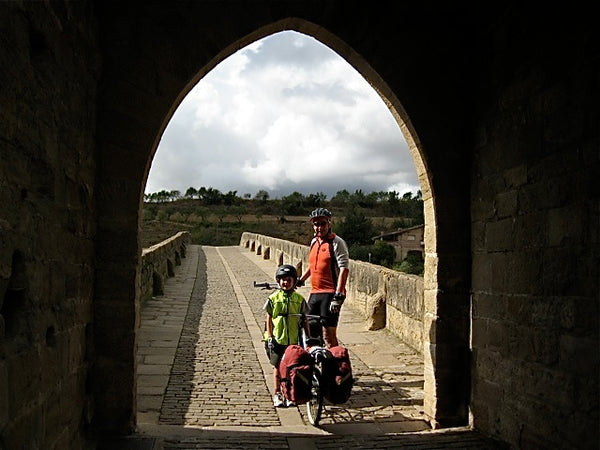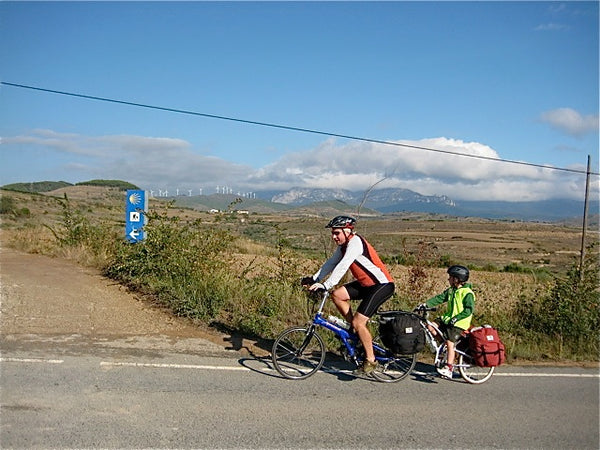Your Cart is Empty
Gear
FAQ
Blog
Stairway to Heaven - biking Spain's Camino de Santiago
01 February 2008
by Fraser McLachlan
Like most of Europe, Spain has long been influenced by the ebb and flow of humanity. In the ninth century the church had the good fortune to 'rediscover' the remains of Saint James near the town that became Santiago. They encouraged religious pilgrims to visit Santiago to have their sins absolved and take another step on the 'stairway to heaven'.

A millennium later the Camino de Santiago is more popular than ever. In true pilgrim style there are many routes that all eventually arrive at the cathedral so you can embrace the religious statues. The best known is the French Way. It dawdles down France, crosses the Pyrenees to Pamplona, and then heads to Cape Finisterre, the western-most point on mainland Europe. The Cape is100km beyond Santiago and in the Middle Ages was thought to be the 'end of the world' as you can gaze over the Atlantic with a seemingly endless horizon.

Cycle touring the Camino looked to be quite straightforward. As a recognised route, English guides and maps were easy to obtain, while the pilgrims' accommodation would save us from carrying tents. We'd be travelling in October - a bit late in the season for predictable weather, but compensated for with fewer tourists and other pilgrims. The walking route is subdivided into 31 stages of 20-30km from Saint-Jean-Pied-de-Port all the way to Santiago de Compostela. On bikes we could cruise two or three of these stages each day, a daily average of around 60km over two weeks. We opted to skip the first day's riding by starting in Pamplona, as logistics on the French side were a bit tricky, leaving around 720km to reach Santiago.

And so after enduring the standard start-of-trip obstacles (travelling with children, delayed flight from Italy, frantic taxi ride through Barcelona, night train across Spain), we found ourselves deposited on a wet platform at the Pamplona railway station at 5.30am. Pamplona is best known for the festival of San Fermin and the running of the bulls, but there were no cows in sight as we trundled into a deserted square early in the morning. After a pleasant few hours gaining our bearings we drifted a short distance to the closest old town and found a well-recommended 'albergue', the local name for a pilgrims' hostel. There we collected our 'credencials', the passport indicating our pilgrim status and record of where we stayed en route. As the afternoon drew on, a varied collection of other pilgrims drifted in. This became the routine. An early start, a short hour on the bikes to warm up and get some distance under our belts. Invariably we'd find a coffee at the nearest bar before moving on to a bigger town for lunch, followed by another stint to our chosen hostel for the afternoon and evening.

Quite where we ended up each day depended on our enthusiasm and experiences along the way. Knowing there was at least one option of a cheap bed every twenty or so kms made indecision perfectly okay. Unlike some other tours where finding a bed becomes increasingly fraught, this was never a hassle on the pilgrim route. Accommodation costs ranged from free(!) to just seven euros each per night, well below any other options.
The scenery across the north of Spain is not exactly wilderness. There are vast expanses of tilled fields growing wheat and sunflowers. Historically there were large oak forests but they were chopped down in the 17th century to build the Spanish Armada. The rolling countryside makes for easy cycle touring, although most of the 150,000 pilgrims who travel the route each year are on foot not bikes. The route traverses several different regions of Spain. Starting in the Pyrenees it passes through Navarre, on to the Basque area, into Castille and Leon, then finally to the wild Atlantic region of Galicia. Each has its own character and intense history. So this is touring with a major cultural overlay. No English is spoken in the north, so a modicum of language is required to get by.

As you leave Pamplona and head across the Navarre, the wide-open landscape is punctuated by the occasional massive wind farm. Although brown dirt and huge blue skies are ever present, most of the route is 800m above sea level making the weather unpredictable. We managed to escape any rain, but the mornings were cool (4°C) and there was little wind. A more normal weather set would have included the odd storm with short bursts of heavy rain. The central part of the route is a very flat plain called the 'meseta' - deadly dull on foot but a breeze to cycle through. We covered the several hundred kilometres in three days to reach the wooded hills of Galicia. This provided respite from the tedium of the mesata but the Atlantic weather can sweep in and there are a couple of 800m hill climbs. The French Way is marked with the ubiquitous scallop shell trail markers every 500m. The shell signifies making the pilgrimage all the way to the far coast. We rode mainly on the adjacent sealed byways, and on the gravel camino itself where possible. If not weighed down by children and trailers we could have stayed off-road the whole way, but the sealed road was less energy sapping and mostly runs right next to the trail.

Highlights along the way included: the cathedrals of Burgos, Leon and of course Santiago de Compostela; an unexpected evening at Granon - sleeping in a belltower and a round table discussion in Spanish, French, Italian and English; various Roman remnants including bridges, arches and a great 4th century mosaic floored villa; tortilla patatas every brunch and unlimited Vino Tinto with each meal; ten euro pilgrims menus in dodgy cafés; and hot chocolate with marmalade toast served by white-jacketed waiters in Leon.
The church was reluctant but eventually relented and issued us with our 'compostela' certificate at the end of our trip. If you feel the urge for a few weeks in Spain, consider the Camino de Santiago. The medieval flavours mixed with a hefty dose of culture made for a great trip. Buon Camino.
Nitty Gritty
- There's plenty of information available about the route, hostels and eating options along the way. Check out:
- everest.es publish 'The Road to Santiago'- the best English guide with maps.
- caminodesantiago.me.uk for general route info.
- csj.org.uk for guidebooks and current updates.
- godesalco.com for route planning including contours. For getting there and away there are the usual suspects. We found the following sites useful:
- renfe.es for Spanish Railway bookings online (not Mac compatible though).
- clickair.com for budget airline travel within Spain and Europe.
- The Camino is suffering from too many pilgrims. Plan to avoid the busy months of June, July, August and September- and go soon before the experience is lost to the masses.
- The Spanish economy has been in overdrive for the past decade. Apart from the incredibly cheap pilgrims' hostels, most things in Spain cost a lot. And new wealth has resulted in many new roads, ugly housing and industrial developments, slightly detracting from the medieval flavour of the region.
UnderGround email List
Join our UnderGround newsletter for regular updates from our blog, new product releases and hot deals.
UnderGround email List
Join our UnderGround newsletter for regular updates from our blog, new product releases and hot deals.
